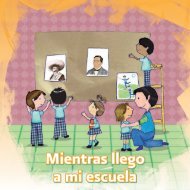Spanish for K-8 Heritage Speakers: A Standards-Based Curriculum ...
Spanish for K-8 Heritage Speakers: A Standards-Based Curriculum ...
Spanish for K-8 Heritage Speakers: A Standards-Based Curriculum ...
Create successful ePaper yourself
Turn your PDF publications into a flip-book with our unique Google optimized e-Paper software.
40 Hispania<br />
91 March 2008<br />
did I learn about my culture by looking at my own family memories?<br />
Possible Assessments:<br />
* Writing Rubric (Teacher-selected writing rubric)<br />
*<br />
Assessment of graphic organizers <strong>for</strong> story comprehension<br />
*<br />
Anecdotal notes<br />
*<br />
Presentation checklist (Appendix)<br />
Possible Related Activities:<br />
*<br />
Read Magic Windows and create "papel picado"<br />
*<br />
Have students bring in photos of family members and retell the memories though all family members'<br />
*<br />
perspectives<br />
Interview family members about their childhood memories and create a family "scrapbook"<br />
Suggested Resources:<br />
In My Family, En mi familia, Carmen Lomas Garza, et al.<br />
Family Pictures, Cuadros de familia, Carmen Lomas Garza, et al.<br />
Family, Familia. Diane Gonzales Bertrand, Guillermo Jorge Manuel Jos?, Mem Fox<br />
Making Magic Windows: Creating Papel Picado/Cut-Paper Art with Carmen Lomas Garza<br />
Homenaje<br />
a Tenochtitlan: An Installation <strong>for</strong> Day of the Dead by Carmen Lomas Garza<br />
Hairs/Pelitos by Sandra Cisneros<br />
Just Like Me: Stories and Self-P or traits by Fourteen Artists, Harriet Rohmer (Hardcover)<br />
Sixth Grade, Quarter 3<br />
This learning<br />
scenario<br />
addresses the<br />
following:<br />
National<br />
Foreign<br />
Language<br />
Standard(s):<br />
1.3<br />
WIDA SLA<br />
standards:<br />
lC3f,<br />
2A3g, 2B3g,<br />
4A3e<br />
AATSP SNS<br />
Concept(s):<br />
1. Motivation and<br />
Self-Esteem<br />
2. Dealing with Errors<br />
5. Cultural Diversity<br />
9. Metalinguistic skills<br />
Illinois Learning<br />
Standard(s) <strong>for</strong><br />
additional<br />
Content Area(s):<br />
18A3 Social Sciences,<br />
26.B.3d Visual Arts<br />
(Fine Arts)<br />
Guiding thought:<br />
Big Idea: Nosotros: Productos de nuestra cultura<br />
Familiar Heroes<br />
Familiar Heroes: Family is Important!<br />
Learning Scenario Objective:<br />
The students will use the writing process (pre-writing, outline, draft, re<br />
draft, final draft) to compose original personal essays about the important<br />
Hispanics in their lives.<br />
Suggested<br />
Time Frame: 4 weeks<br />
Descriptors:<br />
1. Students will respond to the story El Juego de la Loter?a from per<br />
sonal, cultural, creative, and critical points of view. WIDA lC3f<br />
2. Students will write in order to reflect the important values in their<br />
families and communities. WIDA 2A3g<br />
3. Students will edit and revise a personal essay in <strong>Spanish</strong> using pro<br />
cesses of revision that take into account teacher and peer feedback.<br />
WIDA 2B3g<br />
4. Students will begin to recognize and correct common errors made by<br />
native speakers of <strong>Spanish</strong> in writing. WIDA 4A3e<br />
Areas: (1) Reading and Literature; (2) Writing; (4) Language<br />
Learning<br />
Part I<br />
scenario:<br />
Use and Structure<br />
Students will create an essay about somebody Hispanic who has had an im<br />
pact on them or on their community and then create an artistic portrait of the<br />
person written about in the essay. In order to inspire creative writing in the<br />
students, the teacher will read them a bilingual picture book called Playing<br />
Loter?a/El Juego de la Loter?a by Ren? Colato La?nez about a little boy who<br />
doesn't speak much <strong>Spanish</strong> and goes to visit his grandma in Mexico. He teaches<br />
her English, and she teaches him <strong>Spanish</strong> through the use of the Mexican game,<br />
la Loter?a. It is important to the purpose of the book that both the English and<br />
<strong>Spanish</strong> parts are read. The teacher should elect someone to read the English<br />
part of the story, preferably a non-native speaker of <strong>Spanish</strong> (this corresponds<br />
to the plot). After reading the story, the teacher should lead a discussion with the<br />
students of how the little boy felt that even though he was Mexican,<br />
speak <strong>Spanish</strong>. The teacher might ask: Do all Hispanics speak <strong>Spanish</strong>?<br />
Hispanics that speak <strong>Spanish</strong> speak <strong>Spanish</strong> in the same way?<br />
he did not<br />
Do all



